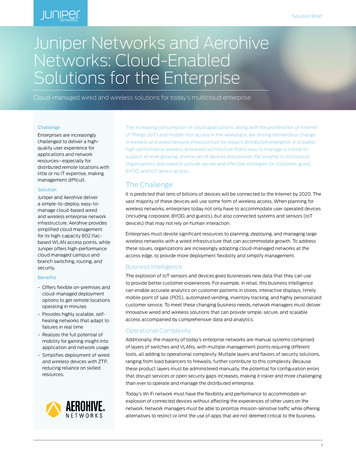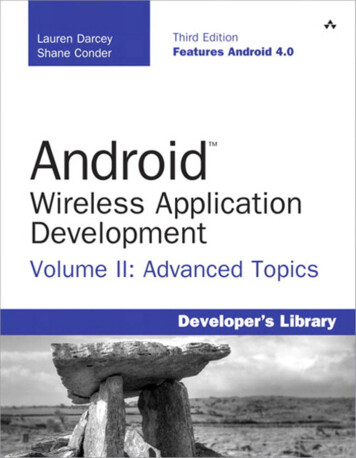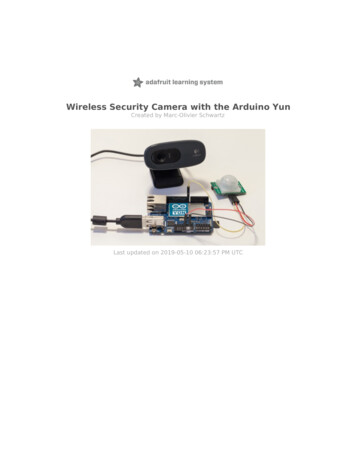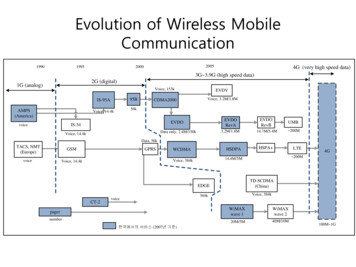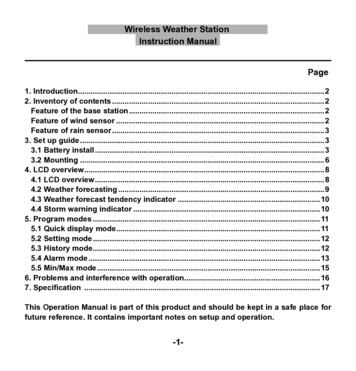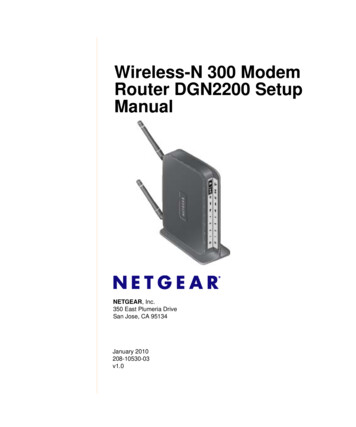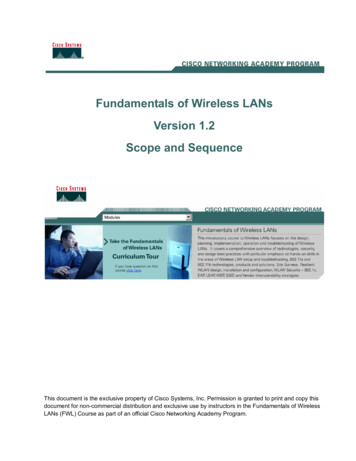
Transcription
Fundamentals of Wireless LANsVersion 1.2Scope and SequenceThis document is the exclusive property of Cisco Systems, Inc. Permission is granted to print and copy thisdocument for non-commercial distribution and exclusive use by instructors in the Fundamentals of WirelessLANs (FWL) Course as part of an official Cisco Networking Academy Program.
TABLE OF CONTENTSTARGET AUDIENCE . 3Prerequisites .3Target Certifications .3Course Description .3Course Objectives .4Lab Requirements.4Minimum System Requirements .4Course Overview.7Course Outline .8Module 1: Introduction to Wireless LANs.8Module 2: 802.11 (a,b,g) and Network Interface Cards .9Module 3: Wireless Radio Technology .11Module 4: Wireless Topologies.13Module 5: Access Points .14Module 6: Bridges.16Module 7: Antennas .17Module 8: Security .19Module 9: Application Design and Site Survey Prep.21Module 10: Site Survey .22Module 11: Troubleshooting Management, Monitoring, and Diagnostics.24Module 12: Emerging Technologies .25Copyright 2005, Cisco Systems, Inc.Fundamentals of Wireless LANs v1.2Page2 of 28 pages
Target AudienceHigh School, Community College (and equivalent), Military and University students aswell as transitional workers enrolled in the Cisco Networking Academy Program.PrerequisitesContinuing Academy students should have completed at least CCNA module 3.Students without previous Academy experience should have equivalent knowledge andexperience, specifically fundamental knowledge of modern computer networks.Target CertificationsThis course will prepare students to take the Wireless LAN for Field Engineers(WLANFE) exam 642-582. This exam is one of several requirements for FieldEngineers supporting a Partner Wireless LAN Specialization. Full details of the examcan be found at:http://www.cisco.com/web/learning/le3/current exams/642-582.html#addrecA current CCNA certification is a pre-requisite to taking the Wireless LAN for FieldEngineers (WLANFE) target certification exam.Course DescriptionThis introductory course to Wireless LANs focuses on the design, planning,implementation, operation and troubleshooting of Wireless LANs. It contains acomprehensive overview of technologies, security, and design best practices withparticular emphasis on hands on skills in the following areas:-Copyright 2005, Cisco Systems, Inc. Wireless LAN setup and troubleshooting 802.11 (a, b, and g) technologies, products and solutions Radio Technologies WLAN applications and site surveys Resilient WLAN products, design, installation, configuration andtroubleshooting WLAN security Vendor interoperability strategies Emerging wireless technologiesFundamentals of Wireless LANsPage3 of 28 pages
Course ObjectivesUpon completion of this course, students will be able to: demonstrate an understanding of wireless radio technologies and topologiesdiscriminate between and describe the IEEE 802.11 wireless standardsconfigure and install various Cisco wireless access points, bridges, adapters,and antennaedemonstrate the concepts of wireless LAN design and installationconfigure, monitor and maintain a WLAN using both CLI and web-basedDevice Manager toolsidentify wireless security threats and vulnerabilitiesconfigure wireless LAN security using MAC filtering, WEP, LEAP, EAP and802.1x technologiesdemonstrate an understanding of proper site survey techniques and safetypracticesconfigure various network monitoring technologies including Syslog, SNMPand loggingtroubleshoot wireless installations and configurationsdemonstrate an understanding of vertical and horizontal wirelessimplementations and usesLab Equipment RequirementsLab Bundles:The equipment required for this curriculum is fully described in the Lab Configurationand Pricing Guide to be found in the FWL Course catalog section of the CiscoNetworking Academy web site. This is kept up to date in terms of pricing andequipment changes.Click here to go to the latest Lab.jsp(you will need a valid Academy logon)This spreadsheet is specific to the United States Networking Academies. Othercountries and domains have different licensing and regulatory requirements for radioand wireless equipment. You may need to work with your local Academy TechnicalManager to determine specific equipment bundles and pricings for your country.Minimum System RequirementsIn order to view and deliver the FWL curriculum, an Academy will need to have the following equipment:Curriculum Requirements:1 PC per student and 1 curriculum serverLab Requirements:4 Lab PCs or laptops (Win 2000 or Win XP (recommended))2 Lab Handhelds (Windows CE) (optional)1 Lab Server (Win Server 2000 or better is recommended, but other configurationscan be utilized eg Linux, UnixPage4 of 28 pagesFundamentals of Wireless LANsCopyright 2005, Cisco Systems, Inc.
Curriculum RequirementsStudent PCThe curriculum may be viewed on a wide range of computers that use various operating systems –Windows; MAC OS; Linux; Unix etc. The machine and associated OS must host a browser such asNetscape 7.0x or 7.1 (only); Internet Explorer 5.5 (SP2); or Firefox 1.x. Other browsers may work but arenot supported.Java, Javascript and StyleSheets must be enabled in the browser preference setting.The Macromedia Flash 7 plugin should be downloaded and enabled. The computer should also have thefree Adobe Acrobat Reader software loaded.The monitor should support, as a minimum, 800 x 600 resolution with a video card supporting a colordepth of 256 colors. The minimum size monitor recommended for a desktop machine is 15 inch (38 cm). Ifavailable, a 17 inch (43 cm) monitor with a 16 bit color depth video card is preferred.The computer will require a sound card, speakers or headphones (preferred) and a mouse. In addition, itshould be fitted with a network interface card (NIC) that supports a minimum of 10MB/s Ethernet.Curriculum ServerAs with the curriculum viewing computers, a wide range of computers and operating systems are availableto host the curriculum locally. However, consideration needs to be given to the number of students thatmay be accessing the machine when considering suitability.The recommended operating system is Microsoft Windows 2000 Server (SP2) or later.The server computer will require 5 to 10GB of hard disk space for the curriculum. The minimumrecommended memory requirement is 256MB.Lab Computer Requirements (Student Pod)PC / Laptop (2 students per machine)Recommended OS - Windows2000 or Windows XP (recommended)600Mhz processor or betterMinimum 256MB of RAMAvailable PCI slot10GB of available hard-disk space for all applicationsColor Monitor with 256-color (8-bit) or better video cardMonitor resolution 800x600 dpi or betterCD-ROM driveIE 5.0, Netscape Navigator 4.7 or Firefox 1.x (or later versions)Copyright 2005, Cisco Systems, Inc.Fundamentals of Wireless LANsPage5 of 28 pages
Cisco Demo and Freeware Applications for Lab Exercises Cisco Secure ACS v3.1.1 or better (to deliver the optional 802.1x security labs) A 90 day trial version of Cisco Secure ACS is available via CCO software center. -eval. A valid CCO license is required. The instructor may have to update the CCO account by completing the high encryption licenseagreement Cisco VPN Client (3.6 or later) (Optional) t/ The instructor may have to update the CCO account by completing the high encryption licenseagreement.Demo and Freeware Applications for Lab Exercises PUTTY SSH Client or equivalento http://www.chiark.greenend.org.uk/ sgtatham/putty/download.htmlSolarWinds TFTP Server or equivalento http://www.solarwinds.net/Tools/Free tools/TFTP ServerKiwi Enterprises Syslog Server or equivalento http://www.kiwisyslog.com/products.htm#syslogSNMP Trap Watcher or tmlServer: (to deliver optional 802.1x Security Labs)Software Platforms Windows 2000 Server with Service Pack 3 installed (eval version or standard 5 or 10 userversions) Windows 2000 Advanced Server, with these additional requirements: o120 day evaluation copy may be available via Microsoftowithout Microsoft Clustering Services installedowith Service Pack 3 installedMicrosoft products can be economically acquired in the United States under the MSDN AcademicAlliance program for 799 USD. See http://www.msdnaa.net for more information.COST CALCULATORThe Wireless Networks Cost Calculator may help to estimate the costs for offering the course.Page6 of 28 pagesFundamentals of Wireless LANsCopyright 2005, Cisco Systems, Inc.
ORDERINGYour Cisco Account Manager can help you when placing an order for equipment.If your Academy is in the United States and you are having difficulty contacting your Cisco AccountManager, please email lab-bundle@external.cisco.com and we will have someone contact you.If your Academy is outside the United States, please contact your Area Academy Manager. To find outwho your Area Academy Manager is, go to your homepage and click on “View Information” under the“Teach” section.Please include the following information in your email: Your full name Your username/userid Academy Name Academy Address Academy City, State/Province, Country, and Postal Code Academy Contact Name and Telephone NumberCourse Overview1.Introduction to Wireless LANs2.802.11(a, b, & g) and Network Interface Cards3.Wireless Radio Technology4.Wireless Topologies5.Access Points6.Bridges7.Antennas8.Security9.Application Design and Site Survey Prep10.Site Survey11.Troubleshooting, Management, Monitoring and Diagnostics12.Emerging TechnologiesCopyright 2005, Cisco Systems, Inc.Fundamentals of Wireless LANsPage7 of 28 pages
Course OutlineModule 1 - 12 OutlineModule 1: Introduction to Wireless LANs1.1 Introduction to Wireless LANs1.1.1 What is a wireless LAN?1.1.2 No more wires?1.1.3 Why wireless?1.1.4 Evolution of wireless LANs1.2 Networking Media1.2.1 Physical layer media1.2.2 STP1.2.3 UTP1.2.4 Coaxial cable1.2.5 Optical fiber1.2.6 Atmosphere: the wireless medium1.2.7 Media installationLab: Wireless Component and Media Identification1.3 Wireless Technologies1.3.1 OverviewInteractive Activity: From LAN to WLAN1.3.2 Digital wireless and cellular1.4 Components and Topologies1.4.1 Components overviewInteractive Activity: Devices Function at OSI Layers1.4.2 Client adapters1.4.3 Access points1.4.4 Bridges1.4.5 Antennas1.4.6 Cables and accessories1.4.7 802.11 enabled devicesLab: Wireless Lab Setup1.4.8 Consumer wireless productsPage8 of 28 pagesFundamentals of Wireless LANsCopyright 2005, Cisco Systems, Inc.
1.4.9 Wireless LAN Topologies1.5 Wireless LAN Market1.5.1 Implications1.5.2 WLAN growth and applications1.5.3 Market requirements1.6 Challenges and Issues1.6.1 Radio signal interference and degradationLab: Challenges of Wireless Regulations1.6.2 Power management1.6.3 Interoperability1.6.4 Network security1.6.5 Reliability and connectivity1.6.6 Installation and site design issues1.6.7 Health issues1.6.8 Future directionsLab: Challenges of Wireless MediaModule SummaryModule QuizModule 2: 802.11 (a,b,g) and Network Interface CardsModule Overview2.1 802.11 Standards2.1.1 Overview2.1.2 IEEE and 802.11Interactive Activity: IEEE 802 Standards2.1.3 IEEE 802.2 LLC review2.1.4 Wireless LAN general description2.1.5 Logical architectureInteractive Activity: WLAN Logical Architecture: Acronym Recognition2.2 802.11 MAC Layer2.2.1 MAC services2.2.2 MAC frame structure, architecture, and operationInteractive Activity: 802.11 MAC Frame FormatCopyright 2005, Cisco Systems, Inc.Fundamentals of Wireless LANsPage9 of 28 pages
2.2.3 Carrier-sense mechanism, MAC-level acknowledgements, and interframe spaces2.3 Physical Layer (PHY)2.3.1 Scope and functions2.3.2 IEEE 802.11b (High–Rate) DSSS PHY specification2.3.3 802.11b modulation2.3.4 IEEE 802.11a PHY specification2.3.5 IEEE 802.11g PHY specification2.3.6 FHSS and Infrared (IR) PHY specifications2.4 Client Adapters2.4.1 IntroductionPhotozoom: Cisco Aironet Client Adapters2.4.2 Parts of the client adapter2.4.3 Driver types and client supportLab: Install a WLAN adapter card2.4.4 Network configurations using the client adapters2.5 Aironet Client Utility (ACU)2.5.1 Overview2.5.2 InstallationLab: Install Aironet Client Utility (ACU)2.5.3 Create and select profiles2.5.4 Edit, import, and export profiles2.5.5 Manage profilesLab: Configure Auto Profiles2.5.6 Configure the client adapterDemonstration Activity: The Aironet Client Utility2.5.7 Aironet Client monitor (ACM)2.5.8 Configure the client IP address2.6 ACU Monitoring and Troubleshooting Tools2.6.1 Overview2.6.2 Status and statistics2.6.3 Cisco WLAN troubleshooting2.6.4 Survey and Link Test ToolPage10 of 28 pagesFundamentals of Wireless LANsCopyright 2005, Cisco Systems, Inc.
2.6.5 Link Status MeterInteractive Activity: Link Status Meter and Free Space Loss SimulatorLab: ACU UtilitiesLab: Creating an Adhoc NetworkModule SummaryModule QuizModule 3: Wireless Radio TechnologyModule Overview3.1 Waves3.1.1 Overview of wavesInteractive Activity: Longitudinal PulseInteractive Activity: Digital Modulation3.1.2 Sine wavesInteractive Activity: Amplitude and FrequencyInteractive Activity: Amplitude, Frequency, and Phase3.1.3 Analog to digital conversionInteractive Activity: Analog to Digital Conversion3.2 Mathematics for Studying Radio3.2.1 Watts3.2.2 Decibels3.2.3 Decibel referencesInteractive Activity: Calculating DecibelsInteractive Activity: Using DecibelsLab: Wireless Mathematics3.3 Electromagnetic (EM) Waves3.3.1 Basics of EM wavesInteractive Activity: Propagation of Light in MatterInteractive Activity: Electromagnetic FieldsInteractive Activity: Electromagnetic Calculator3.3.2 EM spectrum chartInteractive Activity: Electromagnetic Spectrum3.3.3 Fourier synthesisCopyright 2005, Cisco Systems, Inc.Fundamentals of Wireless LANsPage11 of 28 pages
3.3.4 Spectrum uses3.4 Signals3.4.1 Viewing signals in time3.4.2 Viewing signals in frequency3.4.3 Signals in time and frequencyInteractive Activity: Tone Generator Modulation3.4.4 Noise in time and frequency3.5 Modulation Techniques3.5.1 Carrier frequency3.5.2 Basic modulation techniquesInteractive Activity: Digital Modulation3.5.3 FHSSInteractive Activity: Frequency Hopping Spread Spectrum3.5.4 DSSS3.5.5 OFDM3.6 Multiple Access and Bandwidth3.6.1 Multiple access to shared medium3.6.2 WLAN DSSS and CSMA/CAInteractive Activity: Allocating Communications Resources3.6.3 Bandwidth3.7 Radio Wave Propagation3.7.1 Propagation of RF3.7.2 RefractionInteractive Activity: Optical Refraction3.7.3 ReflectionInteractive Activity: Law of Reflection3.7.4 Diffraction and scattering3.7.5 MultipathInteractive Activity: Multipath3.7.6 Path-lossInteractive Activity: The Free-Space Loss (FSL) EquationInteractive Activity: Free Space Loss SimulationPage12 of 28 pagesFundamentals of Wireless LANsCopyright 2005, Cisco Systems, Inc.
Module SummaryModule QuizModule 4: Wireless TopologiesModule Overview4.1 Components4.1.1 Laptops and workstations4.1.2 Mobile computers, PDAs, and barcode readers4.1.3 Clients and adapters4.1.4 Access points and bridges4.1.5 Antennas4.1.6 Ethernet and wired LANsInteractive Activity: Layer LaunchInteractive Activity: Devices Function at OSI Layers4.2 WLAN Topologies4.2.1 ModularityInteractive Activity: Cisco Three-Layer Internetwork Design Model4.2.2 WLAN categoriesInteractive Activity: Bridged WLANs4.2.3 Local area networks (LAN)4.2.4 Wireless repeater4.2.5 System redundancy and load balancing4.2.6 Roaming4.2.7 Scalability4.3 Channel Setup4.3.1 Overview4.3.2 Access point coverage and comparison4.3.3 Multirate implementation4.3.4 Channel usage and interference4.4 Bridge Topologies4.4.1 Root modesCopyright 2005, Cisco Systems, Inc.Fundamentals of Wireless LANsPage13 of 28 pages
4.4.2 Point-to-point configurationInteractive Activity: Bridge's Line of Sight4.4.3 Point-to-multipoint configuration4.4.4 Distance limitations4.4.5 Bandwidth4.5 Sample Topologies4.5.1 Basic topologiesInteractive Activity: Name that Topology4.5.2 Campus topologies4.5.3 WLAN addition to AVVIDInteractive Activity: Vocabulary CheckInteractive Activity: Cisco Integrated SolutionLab: Topology Design with Cisco Network Designer (CND)4.6 VLAN, QoS, and Proxy Mobile IP4.6.1 VLAN features4.6.2 Quality of Service (QoS) feature4.6.3 eDCF4.6.4 Proxy mobile IPModule SummaryModule QuizModule 5: Access PointsModule Overview5.1 Access Point Connection5.1.1 IntroductionPhotozoom: Cisco AP1100 Access PointPhotozoom: Aironet 1200 seriesPhotozoom: Cisco AP350 Access Point5.1.2 Radio upgrade5.1.3 Cable and power the AP5.1.4 LED Indicators5.1.5 Connecting to the AP5.1.6 Reset the APPage14 of 28 pagesFundamentals of Wireless LANsCopyright 2005, Cisco Systems, Inc.
5.2 Basic Configuration5.2.1 Configure IP address and SSID via IPSU5.2.2 Navigating the GUILab: Configuring Basic AP Settings5.2.3 Configure basic settings via GUI5.2.4 Navigating the CLILab: Using features of the Internetworking Operating System (IOS) command lineinterface (CLI)5.2.5 Configure basic settings via CLIDemonstration Activity: Configure IP Address using VxWorks MenuDemonstration Activity: Config
Cisco Demo and Freeware Applications for Lab Exercises Cisco Secure ACS v3.1.1 or better (to deliver the optional 802.1x securit

